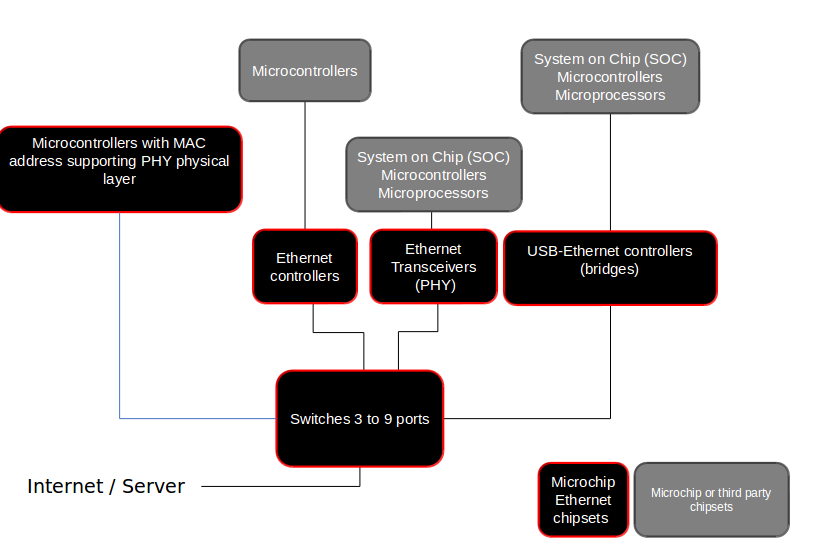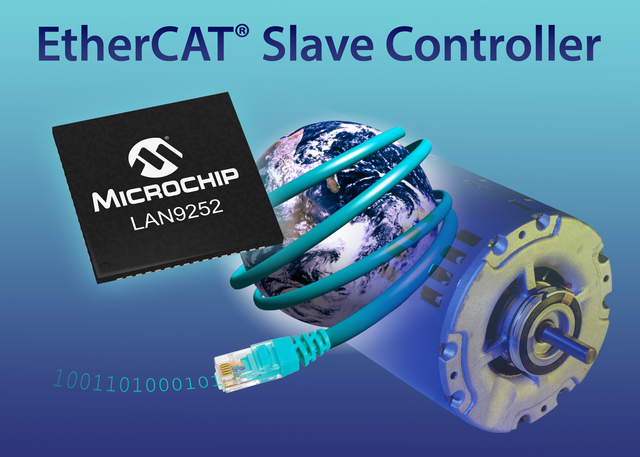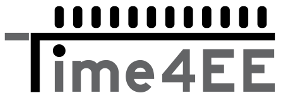Microchip's Ethernet solutions
- February 16 2018
- Commercial Announcement
- 2233 Reads
- 0 Comments

Until recently, Ethernet networks have been classified as networks for office applications. They are now becoming more common in industrial process control applications and even in safety systems applications. Ethernet networks have numerous advantages. What are those advantages? Let's find out by looking at solutions from Microchip Technology.
It can be noted that in recent years solutions based on sending data through an Ethernet network are becoming more common in industrial installations. Using Ethernet as a universal medium for data transfer to control production processes, and in the business management segment, offers numerous benefits. Most importantly, it allows for replacing multiple types of existing networks with a single network.
Typical network structure
Historically, manufacturing facilities had the following network structure levels:
? sensors and actuators level
This level was characterised by a large number of devices and small amounts of data transferred between them.
? control level
This level featured controllers (e.g. PLCs) ? there were less of them than on the aforementioned level, but more data was transferred between them.
? monitoring level and management level
These levels had a small number of devices, but considerably more data was transferred between them. At the same time, the information sent on this level was not critical for the manufacturing process. Meanwhile, the data sent on two lower levels (sensor and actuators level and control level) required maintaining strict transmission time regimes and ensuring that messages reach their destinations. Until recently, an industrial facility needed to have several network types to meet all these requirements. However, this made the networks difficult to maintain and integrate.
Ethernet network characteristics
It might seem that Ethernet networks could always simultaneously handle large numbers of devices (nodes) and sending of large amounts of data. However, the fact that Ethernet networks were using a non-deterministic data transfer protocol was causing problems. The table below shows main differences between protocols.
| Deterministic protocol | Non-deterministic protocol |
|---|---|
| node sends a message when its turn comes | node sends a message when the connection is open |
| nodes can be assigned priorities | each node has equal rights |
| only one node sends messages at a time | a competitive mechanism ? possible collisions |
| limited transmission rights (priorities) management | problems with several nodes simultaneously accessing a transmission medium |
The development of Ethernet networks allowed the limitations of their non-deterministic nature to be gradually eliminated. Currently, Ethernet networks are a good alternative to traditional networks, thanks to their constantly increasing resistance to interference, transmission reliability, and large bandwidth.
What's more, Ethernet allows for:
? secure online monitoring of systems;
? precise control of the industrial processes in manufacturing facilities;
? integration of devices using the popular and well-established interfaces such as SPI, 8/16-bit parallel communication and USB interfaces.
Regardless of the type of data sent through an Ethernet network, the transmission control protocol is comprehensive and complex. The following are specified and standardised: transmission media (cables), signals, frame formats, protocols used. Ethernet specifications are given in the IEEE 802 standard.
Ethernet products from Microchip Technology
Microchip Technology's offer includes many products dedicated for Ethernet data transmission control. The company's main focus was easy implementation. Advanced technologies and mechanisms that ensure maintaining a high quality of data transfer processes were used in these chipsets. They were tested extensively for compatibility with solutions available on the market and their respective standards. Microchip Technology provides its customers with free software and drivers.
It should be noted that due to the level of complexity of protocols used in Ethernet networking, the transmission control systems ? that fully utilise the capabilities of such networks ? are for the most part designed for compatibility with microprocessor systems. At the same time, 90% of industrial equipment that supports Ethernet transmission is controlled by Linux-based operating systems, and the vast majority of controllers are compatible with Linux. Microchip Technology provides evaluation kits, which can be used as reference solutions. Furthermore, the producer's offer includes the LANCheck? service, which consists of checking and optimising the application's design with the client. Microchip's solutions include chipsets that can operate in an industrial range of temperatures (-40?C to +85?C) and chipsets that comply with the Automotive (AEC-Q100) standard.
Below are the types of Microchip products dedicated to data transmission control in Ethernet networks:

Selected technologies in Ethernet chipsets from Microchip Technology
The Ethernet-supporting chipsets are continuously being developed in the following fields:
I. Reducing power consumption
Reducing the devices' power consumption is extremely important, especially since there are laws regulating this issue. Since Ethernet is a part of many systems: microprocessor systems, data centres, and IoT devices, Microchip Technology has implemented the following solutions:
- An advanced power management mechanism: Ethergreen?. It realises transmissions at the lowest physical layer. Chipsets with this mechanism are compliant with the IEEE 802.3az (Energy Efficient Ethernet, EEE) standard. This system detects the line status. In case of inactivity, system switches to an idle state or enters sleep mode, which reduces power consumption;
- Waking up the system from sleep mode ? realised by the implemented Wake-on-LAN (WoL) function;
- Extremely low power consumption in sleep mode (Signal Detect Wake Up) <1?A.
II. Increased determinism (transmission predictability) in Ethernet networks
- Ethernet node synchronisation mechanism ? using a single, highly precise clock signal (GPS Grand Master Clock). Systems equipped with this mechanism are compliant with the IEEE1588v2 / 802.1AS standard;
- Various mechanisms for shaping packet movement in Ethernet networks, e.g. the AVB (Audio Video Bridging) mechanism which is used as a method for transporting audio/video stream data through Ethernet. This mechanism allows for assigning priorities to stream data packets, so they can be transmitted while maintaining continuity and delivered to their addressee at a strictly specified time. Another such mechanism is the Time Aware Traffic Scheduler, which also allows for assigning priorities to the transmitted data frames, so they can be delivered in a specified time frame with negligible delay. This mechanism is used for data sent between PLC drivers and actuators (robots) connected via Ethernet.
III. Increasing the data transmission reliability in Ethernet networks
- The Quiet-Wire? mechanism increases the systems' resistance to noise interference which may impair transmission and is created by external devices and transmission media of potentially questionable quality (low quality cables). At the same time, the noise generated by systems with Quiet-Wire? is minimal. This allows for cost-effective cables to be used, while maintaining a large transmission range (?170 meters by default);
- Mechanisms for detecting and automatically fixing potential transmission errors: special protocols such as DLR (Device Layer Ring) and HSR (High Seamless Redundancy). When the DLR protocol is active, the Ethernet network is organized into a "ring" structure. The HSR protocol introduces redundant packets for critical information into the network.
- The LinkMD? mechanism, which tests and detects hardware malfunctions in the network, such as gaps and short circuits. It detects the malfunction type and its distance from the device using the mechanism.

An overview of Ethernet supporting systems from Microchip Technology
Other than microcontrollers and microprocessors with MAC and PHY layer support, Microchip Technology's offer also includes:
1. Ethernet controllers
These chipsets provide support for the lowest layers of network communication, i.e. physical layer and data link layer (Ethernet controllers have implemented MAC addresses). The chipsets communicate with a supervising microcontroller (MCU) or a microprocessor/system on chip (MPU/SoC) via SPI serial interface or 8-/16-bit parallel interface. A specific interface type determines the maximum speed of data exchange between a controller and a processor, and consequently the speed of data transfer over the network. Technologies used in Ethernet controllers include i.a. EtherSynch?, EtherGreen?(EEE), WoL.
The LAN9250 is an example of an Ethernet controller equipped with advanced mechanisms. It supports the Ethernet 10Base-T/100Base-TX communication standard and is supplied in a QFN64 or TQFP64 package. Microchip Technology also offers simpler models, dedicated to less demanding applications, which support the Ethernet 10Base-T standard of communication. The popular ENC28J60 is one of those controllers.
2. USB-Ethernet controllers (bridges)
You can choose from about a dozen of Ethernet controller types with USB interfaces, which allow for quick data exchange between a controller and a microprocessor. The USB-Ethernet bridges can also be used to build an USB-Ethernet adapter, which can act as e.g. an external network card.
The LAN7850 is one of those chipsets. It supports Ethernet communication in the 10Base-T/100Base-T and 1000Base-T (GigE) standards. The data is exchanged with a processor through an USB2.0 interface (with a transmission speed of up to 480?Mbps) or through an HSIC (High-Speed Inter-Connect) interface, which is a low-power variant of the USB interface, no larger than 10?cm, used for direct, wireless communication between chipsets. The LAN7850 features the NetDetach? technology (a supervising microprocessor setting that switches it to a low power consumption mode when no data is transferred in the Ethernet network) and the WoL mechanism ? thus, it complies with the IEEE802.3az (EEE) standard. The LAN7850 can work in an industrial range of temperatures from -40? C to +85?C. The bridge is supplied in a SQFN56 package. Microchip Technology provides drivers for the following operating systems: Linux, Mac OS, Windows.
3. Ethernet transceivers
Ethernet transceivers are transmission and reception devices operating at the lowest physical layer of network communication (PHY). The transceivers communicate with devices at higher network layers via MII/RMII interfaces ( Ethernet 10/100Base-T transmission standard) or GMII/RGMII interfaces (Ethernet 1000Base-T transmission standard). These chipsets feature such technologies as: EtherGreen? (EEE), Quiet-Wire?,LinkMD?, WoL.
The KSZ8061 (10/100Base-T) is a functionally advanced transceiver, which ? other than the aforementioned technologies ? features mechanisms which force deterministic (predictable) data transmissions in Ethernet networks. The KSZ8061 is supplied in a QFN32 package and comes in an automotive industry variant (complies with the AEC-Q100 standard).
4. Network switches
Network switches are used when there's a need to connect several network segments or workstations together. Switches operate at the data link layer ? they analyse MAC addresses of the sender and the addressee. Thanks to that, unlike hubs, switches do not transmit electrical signal from a single port to all the remaining ports. Instead, they only transmit it to the network segment where the addressee is located. Thus, the possibility of collisions is lowered, and the actual data transmission speed is improved.
Currently, several dozen switches made by Microchip Technology are available. They support from 3 to 9 Ethernet ports. One of the most recent models is the KSZ9477. It has 7 Ethernet ports and supports GMII/RGMII/MII/RMII interfaces. The chipset's internal register is accessible via the SPI or I2C interface. The KSZ9477 features such technologies as EtherSynch?, AVB, WoL, and mechanisms facilitating the use of DLR and HSR protocols. This switch can work in an industrial range of temperatures (from -40? C to +85?C) and is supplied in a TQFP128 package.
Summary
Selecting a controller depends primarily on the application's specifics. Some applications require only a simple SPI controller, others may require an USB controller. However, when creating a network comprised of several workstations, using a network switch can significantly improve the bandwidth. In order to make the right choice, it's good to know what kinds of chipsets can be found on the market and be familiar with their basic specifications. At the same time, there is no doubt that Microchip Technology is one of the world's largest manufacturers of this type of products. Various types of chips supporting communication over Ethernet are available in the offer of Transfer Multisort Elektronik ? an official distributor for Microchip. More information can be found at www.tme.eu.


